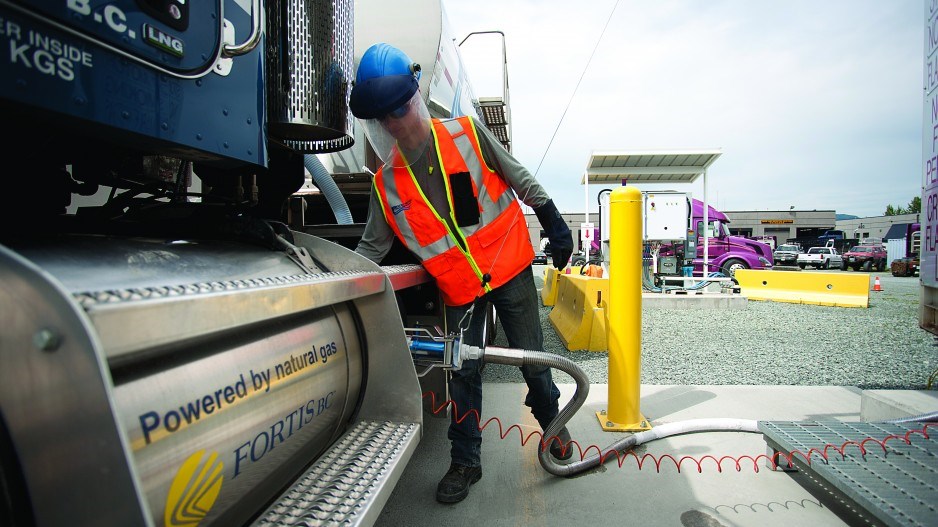Proponents of the green economy often talk about the economic opportunities that transitioning to low- or zero-carbon energy presents, while downplaying the high costs that may come with it.
But there is one sector where the transition could indeed provide significant opportunities for B.C. companies: freight.
The movement of goods by ship, truck, rail and air accounts for 10.5% of Canada’s greenhouse gas emissions (GHGs), according to a recent Pembina Institute study, with freight by truck the fastest-growing source of those emissions.
Thanks to B.C.’s ports and an international airport, the GHGs from the movement of freight are even higher in this province than in some others. As Canada’s economy continues to grow, freight-sector emissions are expected to surpass those from passenger vehicles by 2030.
“These largely unchecked emissions could prove to be a huge roadblock for Canada to meet its climate targets and live up to its Paris Agreement commitment,” the Pembina report warns.
Fortunately, it’s one sector that could be a relatively easy get, in terms of switching to lower- or zero-emission alternatives, and some progress is already being made.
While cargo airplanes won’t be running on battery power any time soon (if ever), the marine and trucking sectors have already begun the move to lower-emission fuels, and even railway companies are now exploring conversion to lower-carbon fuels.
The conversion movement presents opportunities for B.C. companies like Westport Fuel Systems Inc. (TSX:WPRT), Corvus Energy and Ballard Power Systems Inc. (TSX:BLDP). It presents a particularly big opportunity for FortisBC, especially in the marine sector.
Thanks to international emissions regulations coming into effect in 2020 for international shipping, large cargo and container ships will be forced to reduce their sulphur emissions, and liquefied natural gas (LNG) is one of the favoured fuel alternatives.
FortisBC is the only company producing LNG in B.C. for the marine and trucking sectors.
“The opportunity on the marine side is huge,” said Sarah Smith, director of natural gas transportation for Fortis BC.
“Because of the fact that we have very competitively priced LNG here in British Columbia, we have the opportunity to create a global LNG bunkering hub.”
She said that 70% of the world’s marine fuel is provided by just 10 ports, and that 70% of the operating costs for shipping are for fuel.
“What that means is that if an operator can purchase fuel at a lower price in one port over another, and doesn’t have to go too far out of their way to fuel up, that’s where they will bunker.”
Switching from diesel to LNG or compressed natural gas (CNG) can result in 15% to 30% lower carbon dioxide emissions, not to mention lower sulphur and nitrogen oxides.
The first sector to make the switch in B.C. was trucking. Companies like Vedder Transport now use natural-gas engines developed by Westport to replace diesel motors in their long-haul trucks.
In the past five to seven years, a total of 125 long-haul trucks in B.C. have converted to LNG, and another 90 shorter-haul trucks have converted to CNG.
On the marine side, Seaspan Ferries Corp. has been a leader in cargo vessel conversions. It now runs two hybrid cargo ferries that run on LNG and Corvus batteries. Corvus has sold 80 of its lithium-ion batteries for hybrid or all-electric ships, mostly in northern Europe.
“Adoption’s been slower here,” said Sean Puchalski, vice-president of strategic marketing and accounts for Corvus.
“But of course in the Lower Mainland here we have Seaspan Ferries setting the precedent. They have two hybrid ferries and are planning three more, so they are leading the way.”
The one laggard in the freight sector has been rail. Canadian National Railway Co. (TSX:CNR) has experimented with an LNG locomotive pilot project, but no Canadian rail operator has announced plans to convert locomotives to LNG.
Meanwhile, China is taking the lead in making an even bigger leap. CRRC Corp. Ltd., a Chinese rolling-stock manufacturer, is now making railway trams powered by Ballard fuel cells.




